Designers show how electric cars could reshape cities
Jaguar designer Ian Callum and leading architects present vision for future
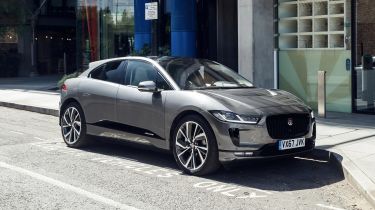
Electric cars could be the catalyst for major transformation of urban environments around the world, according to Jaguar design director Ian Callum and leading architect Jon Eaglesham, managing director of London firm Barr Gazetas. The pair presented a joint vision for what the urban future of automotive electrification could look like at an event in the Stratstone Mayfair Jaguar dealership in central London.
Design freedom
Speaking at the event, Jaguar I-Pace designer Callum said: "As a designer, I'm hugely excited by the opportunity this widespread adoption of electric cars presents. We have a unique chance for wholesale change of the facilities available to drivers as we reinvent usage and ‘filling’ patterns for our vehicles. The concepts we are presenting show a vision of what is possible, what is needed and what it could look like.
"There's a natural synergy between car design and architecture, and architects are generally very keen on sustainability. For car designers, electrification allows us to do something different – it's the most freedom I've had in 40 years of designing cars."
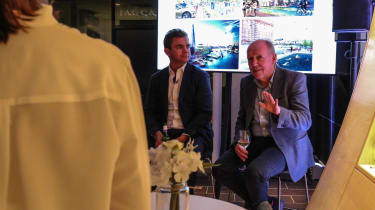
Callum described how he first came up with the concept of large 'cab forward' shape family car over 20 years ago, but only with the advent of electrification and the removal of constraints associated with the positioning of internal-combustion engines was he able to put the idea into production as the I-Pace.
Eaglesham added: "This study is all about realising opportunity. These four concepts should all be possible within a generation. Electric vehicle successes such as the I-Pace represent a huge catalyst for change. As architects, together with town planners and authorities national and local, we need to embrace this opportunity now, and bring visions such as these to reality, improving experiences, and indeed lives, up and down the country.
"It's about making electric cars more convenient, by putting the right type of chargers in the right places. After all, internal-combustion cars aren't inherently convenient – it's fuel stations that make them convenient."
Charging destinations
Eaglesham also discussed how the very first 'refuelling stations' were the caravanserai of the Middle East, where nomadic traders watered their camels and horses. These went on to become destinations and communities in their own right, with the 'refuelling' function no longer their primary purpose. He also pointed to 1950s America, where drive-in diners and movie theatres served as destinations where people parked their cars to socialise.
Four concepts for the electric future

Eaglesham and Callum presented four concepts on the night. The first, called 'Today' focuses on what a motorway service station could be. "We take a traditional, tired motorway service station and breathe new electrified life in to it. It's based on Forton Services on the M6. When it opened in 1965, Forton was a beacon of modernity featuring an upmarket restaurant and a sun deck. Today services are often an unpleasant jumble of commercial buildings servicing noisy, polluted motorways.
"With electrification, much reduced noise and pollution together with increased 'dwell time', we see such stations becoming destinations with an array of amenities and services including farm shops, gymnasiums, swimming pools and restaurants to give travellers greater options to occupy the time required to charge their vehicles."
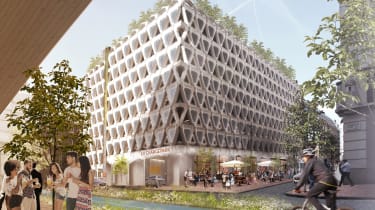
The 'Tomorrow' concept, meanwhile, is based on one of the UK’s most well known multi-storey car parks on Welbeck Street, hidden behind Oxford Street in London’s West End. "The structure symbolises an era of fossil-fuel consumption," Callum and Eaglesham said. "Reimagined as a self-sufficient charging plaza, the proposal is to reinvent the existing stock of city centre multi-storey car parks, where owners of electric vehicles who are less likely to have access to off-street parking at their homes can charge their cars adjacent to good public-transport links. The result is cleaner and greener surroundings and parts of the building freed up for retail and leisure use."
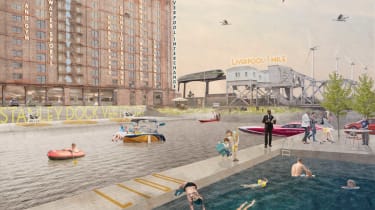
The 'Electric City' concept showcases what Callum and Eaglesham describe as a "fast-approaching reality of completely emission-free major cities. We have taken Liverpool’s Stanley Dock as an example. Built in 1901, it was once the largest building in the world, but fell into disrepair in the 1980s, symbolising lost industry and economic difficulty. In this image, it has been reimagined as a community interchange, helping to rejuvenate the city through the creation of new community facilities and industries based on green energy on redundant sites countrywide."
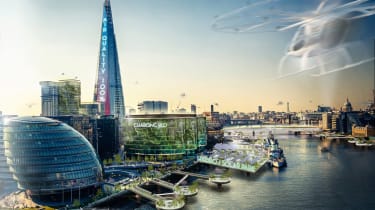
The final concept, entitle 'Electric Future' illustrates "the opportunity for wholesale change, up and down the country. In this image, London is a cleaner, healthier city where repurposed, new infrastructure, connected to electric vehicles, has allowed a proliferation of vegetation and green space. Cities across the UK are electrically self-sufficient, harnessing solar and tidal power to power the increased number of electric vehicles, both land-based and airborne."
Recommended

Jaguar Type 00 finally revealed – dramatic concept maps out British brand’s luxury electric future

Best car manufacturers named in 2024 Driver Power survey
Most Popular
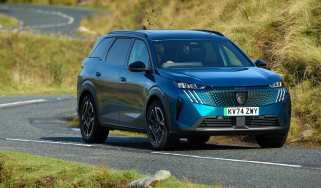
EV Deal of the Day: family-friendly Peugeot E-5008 for £261 per month

EV Deal of the Day: Dacia Spring is amazingly good value at £116 per month
